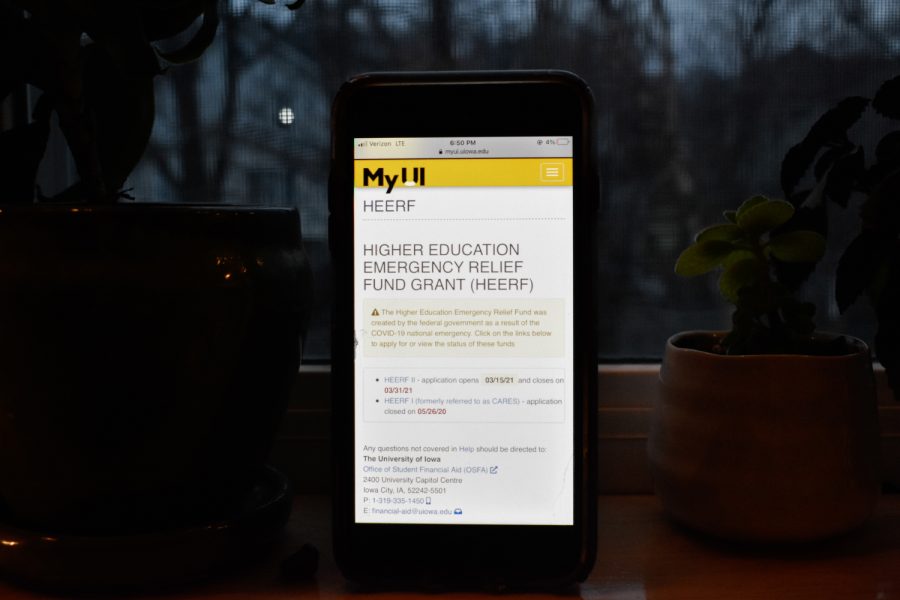Coronavirus relief grant applications open to students through end of March
The Office of Student Financial Aid received 4,966 applications last fall, and expects to exceed this number in the spring.
Photo Illustration by Sid Peterson for The Daily Iowan
March 24, 2021
The Office of Student Financial Aid is currently in the process of accepting student applicants for the Higher Education Emergency Relief Fund II, funds to help those with the greatest financial need, through March 31.
Similar to past relief bills, the American Rescue Plan adds an additional $39.58 billion to higher education through the HEERF formula. The University of Iowa is expected to receive $44,120,495.50 to split evenly between the institution and emergency relief grants to students.
These funds will be available for use through Sept. 30, 2023, the university said in a COVID-19 Update on March 22.
During the first round of these grants last fall, Assistant Provost and Director for the Office of Student Financial Aid Cindy Seyfer said the office received 4,966 applications and awarded 95 percent of those for a total of 4,724 applicants.
“It is a tremendous position that financial aid is in,” Seyfer said. “Generally, we do not have as much money as we need so to be in a position that we are going out saying, ‘We have money, come and apply,’ it was really hard for us to know what we would find.”
When looking ahead to round two of awarding these grants, Seyfer said the office is one week in and has already received slightly over 4,000 applications so far. With the applications open through the end of March, she anticipates the office will receive more.
Seyfer said the office learned to adapt the application time frame and deadline from the first time around to make the process smoother. Another was that the neediest students, for instance, federal Pell Grant students and first-generation students, often need assistance advocating for themselves and applying for these grants.
“I really believe that it is our job then to make sure that those students are still heard and taken care of,” Seyfer said.
One of the differences between the first funding allocation and the second allocation, she said, is the government wants to prioritize exceptional financial need. So, for that reason, it is very important for the office to make sure that those students who do have the highest need are the students who are receiving the support.
“It will make sure more students are aware of it because that is our goal, to get this information and money out to the students that need it,” Seyfer said.
Kelsey Ryder, associate director for the Office of Student Financial Aid said staff have been working with multiple campus groups to get the word out about these funds.
“Information about the HEERF II grant application is being included in multiple campus-wide COVID update emails,” she said. “In addition, we shared information with individual colleges and offices on campus so they could communicate with their student populations.”
Ryder said the office has also utilized their office’s Facebook page to share the HEERF II application and asked USG and GPSG to also share on their social media channels. USG created a TikTok video about the HEERF II application as well.
“We are hoping all of these efforts have helped spread the word so students are aware of the option to apply for the HEERF II grant,” she said.
When choosing who is able to receive these grants, Senior Associate Director for the Office of Student Financial Aid Brenda Buzynski said the office chooses based on guidance from the Department of Education and that students must demonstrate exceptional financial need.
“How we choose is based on our ability to utilize the resources we have available to us within time constraints,” she said.
Within a specific time frame, Buzynski said the office had to develop an application for students to access from MyUI and develop tools to receive, review, and allocate the funds based on a student’s financial need as demonstrated on the 2020-21 FAFSA.
“We are grateful for the IT and data analytics & insight teams we work with to help us effectively allocate funds to our students,” she said.
Seyfer said some of the primary needs for this grant have been focused on basic needs. Paying rent, buying food, and having technology.
“It is very important that students have the technology that puts them in a position to do well in class, to succeed they have to have the right equipment,” she said.
The office also encountered some students who indicated they needed the money for child care, transportation, and medical expenses, Seyfer said.
“We know many students or their parents have experienced job loss, reduced hours, increased technology costs, and many other financial hardships due to the pandemic,” Ryder said.
She hopes these funds will help cover some of those costs. Many college students were also not eligible for stimulus checks, so she is glad that this funding is available to college students.
“I would encourage any student who is in need of assistance with expenses this semester to go to MyUI to see if they are eligible to apply for the HEERF II grant and would remind them that the application will close at the end of the day on March 31,” Ryder said.



